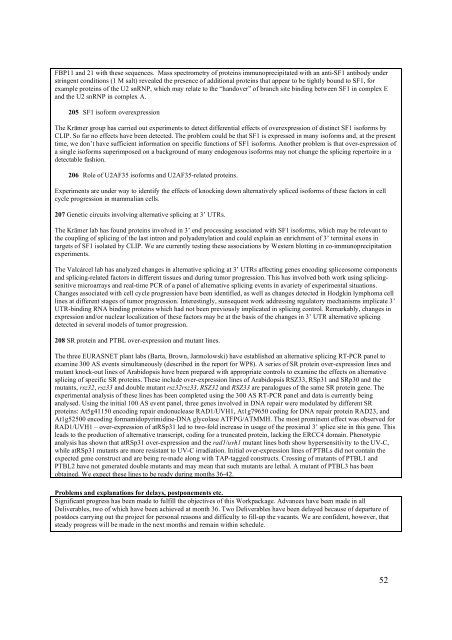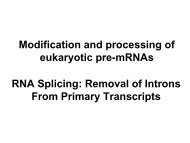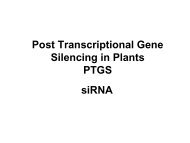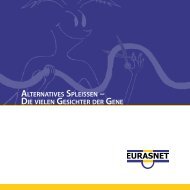Create successful ePaper yourself
Turn your PDF publications into a flip-book with our unique Google optimized e-Paper software.
FBP11 and 21 with these sequences. Mass spectrometry of proteins immunoprecipitated with an anti-SF1 antibody understringent conditions (1 M salt) revealed the presence of additional proteins that appear to be tightly bound to SF1, forexample proteins of the U2 snRNP, which may relate to the “handover” of branch site binding between SF1 in complex Eand the U2 snRNP in complex A.205 SF1 isoform overexpressionThe Krämer group has carried out experiments to detect differential effects of overexpression of distinct SF1 isoforms byCLIP. So far no effects have been detected. The problem could be that SF1 is expressed in many isoforms and, at the presenttime, we don’t have sufficient information on specific functions of SF1 isoforms. Another problem is that over-expression ofa single isoforms superimposed on a background of many endogenous isoforms may not change the splicing repertoire in adetectable fashion.206 Role of U2AF35 isoforms and U2AF35-related proteins.Experiments are under way to identify the effects of knocking down alternatively spliced isoforms of these factors in cellcycle progression in mammalian cells.207 Genetic circuits involving alternative splicing at 3’ UTRs.The Krämer lab has found proteins involved in 3’ end processing associated with SF1 isoforms, which may be relevant tothe coupling of splicing of the last intron and polyadenylation and could explain an enrichment of 3’ terminal exons intargets of SF1 isolated by CLIP. We are currently testing these associations by Western blotting in co-immunoprecipitationexperiments.The Valcárcel lab has analyzed changes in alternative splicing at 3’ UTRs affecting genes encoding spliceosome componentsand splicing-related factors in different tissues and during tumor progression. This has involved both work using splicingsenitivemicroarrays and real-time PCR of a panel of alternative splicing events in avariety of experimental situations.Changes associated with cell cycle progression have been identified, as well as changes detected in Hodgkin lymphoma celllines at different stages of tumor progression. Interestingly, sunsequent work addressing regulatory mechanisms implicate 3’UTR-binding RNA binding proteins which had not been previously implicated in splicing control. Remarkably, changes inexpression and/or nuclear localization of these factors may be at the basis of the changes in 3’ UTR alternative splicingdetected in several models of tumor progression.208 SR protein and PTBL over-expression and mutant lines.The three <strong>EURASNET</strong> plant labs (Barta, Brown, Jarmolowski) have established an alternative splicing RT-PCR panel toexamine 300 AS events simultaneously (described in the report for WP8). A series of SR protein over-expression lines andmutant knock-out lines of Arabidopsis have been prepared with appropriate controls to examine the effects on alternativesplicing of specific SR proteins. These include over-expression lines of Arabidopsis RSZ33, RSp31 and SRp30 and themutants, rsz32, rsz33 and double mutant rsz32rsz33. RSZ32 and RSZ33 are paralogues of the same SR protein gene. Theexperimental analysis of these lines has been completed using the 300 AS RT-PCR panel and data is currently beinganalysed. Using the initial 100 AS event panel, three genes involved in DNA repair were modulated by different SRproteins: At5g41150 encoding repair endonuclease RAD1/UVH1, At1g79650 coding for DNA repair protein RAD23, andAt1g52500 encoding formamidopyrimidine-DNA glycolase ATFPG/ATMMH. The most prominent effect was observed forRAD1/UVH1 – over-expression of atRSp31 led to two-fold increase in usage of the proximal 3’ splice site in this gene. Thisleads to the production of alternative transcript, coding for a truncated protein, lacking the ERCC4 domain. Phenotypicanalysis has shown that atRSp31 over-expression and the rad1/uvh1 mutant lines both show hypersensitivity to the UV-C,while atRSp31 mutants are more resistant to UV-C irradiation. Initial over-expression lines of PTBLs did not contain theexpected gene construct and are being re-made along with TAP-tagged constructs. Crossing of mutants of PTBL1 andPTBL2 have not generated double mutants and may mean that such mutants are lethal. A mutant of PTBL3 has beenobtained. We expect these lines to be ready during months 36-42.Problems and explanations for delays, postponements etc.Significant progress has been made to fulfill the objectives of this Workpackage. Advances have been made in allDeliverables, two of which have been achieved at month 36. Two Deliverables have been delayed because of departure ofpostdocs carrying out the project for personal reasons and difficulty to fill-up the vacants. We are confident, however, thatsteady progress will be made in the next months and remain within schedule.52







